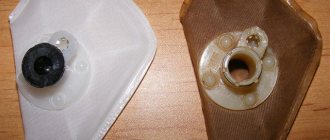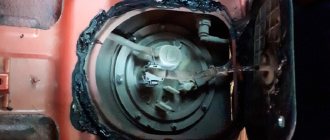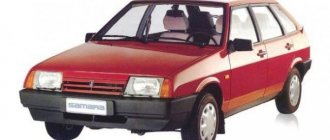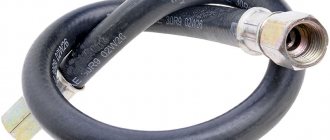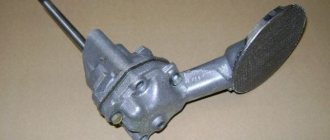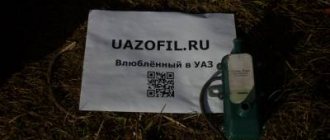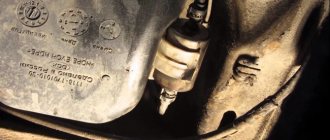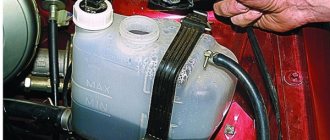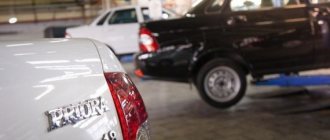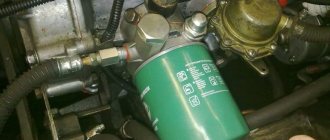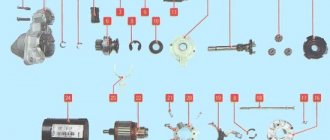How to clean a fuel pump
The fuel tank is the main location of the fuel pump. Its operating principle is that the control unit, immediately after turning off the ignition, forces the gasoline pump to turn on and continue its operation for some time. And this makes it easier to start the engine next time.
The crankshaft position sensor is activated when the engine rotates. The control unit immediately starts the gasoline pump when receiving the signal. But if this signal is not received from the sensor, the gasoline engine, as well as the electric pump, will be stopped. This property increases the battery life. There is a separate relay that helps control the pump in the control unit. If the fuel pump does not turn on, then the first thing to check is the relay.
The uniqueness of Nissan Almera (Nissan Almera) is that the fuel pump has an integrated design, which has a filter designed to clean the fuel. Replacement can only be done together, that is, assembled, since the structure cannot be separated, because it is one-piece.
But this operation is expensive. As a result, we can suggest cleaning the fuel pump on your Nissan. (Although if you still decide to replace the fuel pump, the steps are almost identical to preparing for cleaning).
To clean the fuel pump, you first need to remove it.
How often to change the fuel filter and pump on Almera Classic
According to the factory recommendations for the operation and maintenance of Almera Classic, there are no specific intervals for replacing the gasoline filter. Its resource is designed for the entire service life of the fuel pump, which changes over a mileage of one hundred to two hundred thousand kilometers. The fuel filter and pump are replaced as an assembly.
When carrying out independent maintenance of the fuel system, when the filter element is replaced separately, replace it at intervals of 45,000-60,000 km.
Fuel pump
Removing the fuel pump
First you need to remove the rear seat element. The gasoline pressure must be relieved in the fuel line. The fuse box, which is located under the dash on the driver's left side, must be open. There is usually a marking on the top (cover) that makes this fuse easy to find as it is labeled FUEL PUMP. It should be in the second column (fourth from the top), and also have the designation 15A. The fuse must be removed from the socket. Start the car, and after 3-5 seconds the engine will stall on its own. This action must be repeated until the engine no longer starts (this usually works after 3-5 attempts). After that, wait a minute and repeat the steps. If everything is done correctly, the pressure will be released almost to the limit, that is, to the end.
If you do not want to find the fuse, you should disconnect the connectors from the flange (located under the seat) of the fuel tank. There is no need to remove the hoses immediately.
You need to remove the filler cap and then relieve the internal pressure in the gas tank. We unscrew the three black plastic bolts and remove the hole cover for inspection. Afterwards, the large plastic nut must be unscrewed by hand. We should be able to see a white glass, where the fuel pump is installed. This is a cylinder measuring 10 by 3 centimeters. Some models have an internal mesh, which is usually yellow with dirt.
The return hose must be removed by accurately pressing the plastic latch. This hose extends from the beginning of the engine, as well as an arrow that is directed to the fuel pump. With a little pressure, approximately one small glass of gasoline will flow out of the hose. The second hose will also need to be disconnected, but in this case nothing will leak out. The most important thing is that you need to be careful so that they are not damaged when removing them.
The connector with the harness must be removed and the fuel level meter, that is, the float located in the tank, disconnected. And then you need to remove the fuel pump itself.
Now you can start cleaning the fuel pump itself.
Which fuel filter should I choose?
The fuel supply complex in Almera Classic provides for the installation of a one-piece module consisting of a fuel pump and a fine and coarse filter element. It is installed directly into the gas tank.
The Almera Classic module can be replaced with an original spare part with article number 1704095F0B or one of the analog versions. These include:
- Kross – KN17-03055;
- Ruei – 2457;
- ASParts - ASP2457.
Coarse filter
Replacing the entire module is expensive. Because of this, Almera Classic owners independently modernize the design, which allows them to change components individually.
As a new gasoline pump, you can use the original Hyundam (art. no. 07040709) or an alternative version of the Bosch gasoline pump from VAZ 2110-2112 (art. no. 0580453453) .
The fine filter is replaced by the following analog components:
- Hyundai/Kia – 319112D000;
- SCT 2.8 – ST399;
- Japanparts 2.2 – FCH22S.
To change the coarse filter in the upgraded Almera Classic gasoline supply complex, you can use:
- KR1111F – Krauf;
- 3109025000 – Hyundai/Kia;
- 1118-1139200 – LADA (for VAZ 2110-2112 models).
Fuel filter hatch
Cleaning the pump
Attention! If this procedure does not produce results, then replacing the fuel pump is inevitable.
You should disconnect the fuel hose (it is always rigid), as well as the sensor and do not forget about the float. Then you need to bend the latches (there are 3 of them) of the pump casing. There, below, under the casing, there is a filter.
After cleaning, you need to assemble it all in the opposite order.
Materials used in these operations:
- rags (required quantity);
- small basin;
- a small glass, approximately 300 ml, to collect gasoline flowing from the hose;
- a fire extinguisher is a must (you never know what can happen);
- cleaning products (acetone, liquid intended for washing the injector).
This procedure takes an hour or two on average. Doing the work yourself can save you quite a bit of money, but it will get you a lot dirty.
Replacement procedure: step-by-step instructions
Before performing operations, you need to prepare the following tools:
- set of wrenches;
- spanning tool (gas wrench);
- wire cutters, pliers;
- a set of screwdrivers with different tips;
- rust removers (solvent, carb cleaner);
- an empty 1-liter container for draining remaining gasoline from fuel lines;
- clean rag.
Work on removing elements must be carried out strictly sequentially. First you need to relieve the pressure in the car's fuel system. The fuse responsible for the operation of the pump must be removed from the mounting block under the instrument panel in the car interior. In the diagram it is marked as fuel pump.
Pump relay
Knowing the exact location of the fuel pump relay in the Nissan Almera H16 is not so important. The element in H16 should be looked for on top of the fuse block, that is, on the cover. The most important thing is that under the hood the relay is located in a block. This rule applies to both Nissan Almera Classic and Nissan Almera N16.
Relays in various versions of Nissan Almera
The fuel pump relay is usually located in the engine compartment; in this case, the marking of this element will be K5. The compartment will be located to the right of the battery, meaning on the passenger side. The lid is held in place with latches that are very easy to snap off. There is one more place where the required element can be located - this is the safety block. It is located next to the driver's right foot. There is a plastic cover that will need to be opened to access the relay. This relay is mainly blue in color.
How to determine a fault in a relay
The main sign of problems in the operation of the fuel pump is the failure of the pump, that is, it simply does not turn on. If the fuel pump on the Nissan Almera N16 does not turn on, then you should not immediately go for a new one; you should check the relay, which, most likely, is the main problem. You can check this assumption by replacing the relay with another one, which you don’t have to buy, since you can use what you already have.
We repeat, but this is important: if the fuel pump does not work, then you should check the relay, since in most cases this is where the whole problem lies.
Signs of a clogged fuel filter
Fine filter
A clogged fuel filter negatively affects the operation of the internal combustion engine, so it is necessary to determine the time to replace it in time. Signs of a clogged gasoline filter:
- Reduced engine traction force. In this case, periodic power failures and its recovery may be observed.
- Unstable engine operation at idle speed.
- Inadequate response of the accelerator pedal, especially when starting the car from a standstill.
- Increased fuel consumption.
- When the transmission is put into neutral at speed, the engine stalls.
- It is difficult to climb uphill because the required speed does not develop.
If the above problems occur, it is recommended to replace the Nissan Almera Classic gasoline filter.
Fine filter
Replacement
Replacing it is very simple, it is probably the easiest thing in the entire car maintenance list. Although this can be competed with by checking the oil level (which is very simple) or refueling (which is even simpler?).
The following algorithm of actions should be performed:
- First of all, you should open the hood.
- Then open the cover of the relay block (held on by latches (usually three)).
- Find the relay labeled K4. The large relay should be on the bottom left, two smaller ones above it, and what we need will be located on the right side of them.
- Pull out the element. The latches must be snapped off from below in order for the relay to be removed.
- Insert new.
In emergency cases, when you urgently need to drive, and there is no extra relay, you can use a mechanism relay, which you definitely will not need. For example, you can use a fog light relay.
Detailed description of replacing the fuel filter and fuel pump
Replacing the Almera Classic fuel pump and filter must be performed in a sequence that will be discussed in detail below. The work will be carried out in three stages: extraction, disassembly and reinstallation.
Required parts and tools
The gasoline pump and filter components are replaced with the following tool:
- gas key
- set of open-end and ring wrenches
- pliers
- Phillips screwdriver and flat blade.
Replacing the Almera Classic fuel filter
You also need to prepare spare parts:
- coarse and fine filter
- fuel pump
- fuel tank flap gasket – 17342-95F0A
- hoses resistant to oil and gasoline, as well as clamps for fixing them
- rags
- solvent
- container for receiving remaining gasoline from the system.
Filter elements and a gasoline pump are selected according to the previously presented articles.
Removing the fuel module
Before dismantling the Almera Classic fuel module, it is necessary to completely relieve the gasoline pressure in the car system. To do this, repeat the following procedure three times at intervals of several minutes:
- Remove the fuse from the interior mounting block, which is responsible for the fuel pump;
- Start the Nissan Almera Classic engine;
- Wait until the engine stalls.
In the future, you will need to move into the car interior and perform the following steps:
- Fold down the lower part of the rear sofa;
- Clean the hatch cover and the area around it from dirt and dust;
- Remove the hatch cover by unscrewing the fasteners;
- Disconnect the supply cable from the fuel pump;
- Start the engine, wait until it stalls;
- Place the container, loosen the clamp of the fuel supply hose, remove the hose and lower it into the container. Wait until the remaining gasoline drains out.
Now you can proceed directly to dismantling the fuel module.
- Using the handles of the gas wrench, unscrew the locking ring of the module. It is necessary to rest them against special plastic protrusions, applying force in a counterclockwise direction;
- Carefully remove the module so as not to damage the fuel level sensor float
Let's sort it out
We begin disassembling the Almera Classic fuel module. It is recommended to follow the following sequence of actions:
- Using a flat blade screwdriver, press out the three plastic clips to dismantle the lower housing;
- The supply wire is disconnected from the gasoline level indicator;
- Holding three clamps, the pump and Almera Classic filter elements are removed;
- By loosening the clamp, the pressure sensor is disconnected;
- Use a rag soaked in solvent to wipe the internal cavity of the housing;
- The condition of the fuel pump, coarse and fine filters is assessed. The first is located at the bottom of the device and can be removed by hand. The second is secured with plastic latches, which should be released using a flat-head screwdriver;
- We compare prepared spare parts by size;
- All sealing rubber bands are removed from the fine filter.
Dirty coarse filter
Installation of a new fuel pump, filters and assembly
The process of reassembling the Almera Classic fuel supply system begins with the installation of sealing gaskets in the fine filter. Then:
- The fuel pump and fine filter element are mounted in its seat;
- Depending on the prefilter, it may be difficult to install. They are due to the presence of two plastic protrusions that prevent the element from being fixed to the fuel pump. Therefore, you will need to grind them off with a file;
- On the pressure sensor you will need to cut a suitable pipe, cutting off the curved part;
- When installing the pressure sensor into the seat, you will need to break off part of the fuel receiver housing, which will interfere with installation;
- We use an oil and gasoline resistant hose to connect the parts of the previously cut fuel pressure pipe. In this case, it is necessary to secure both ends of the hose with clamps. The sensor is secured using the original clamp;
- We install the lower part of the fuel module in place, having previously lubricated the fuel supply pipe. This will allow you to align the tube with the sealing rubber bands without excessive resistance.
All that remains is to install the module in its seat in the reverse order. Do not close the hatch cover until the fuel system is checked. To do this, start the engine and if everything is in order, then turn off the engine and screw the cover into place.
